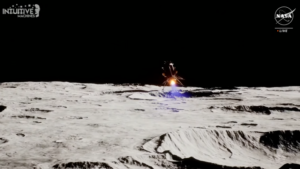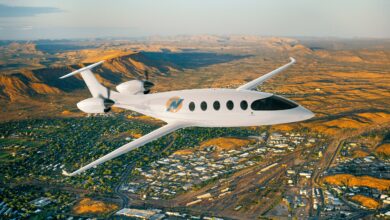Odysseus Touchdown: A New Era of Lunar Exploration Begins
 The ambitious endeavor of a U.S. private company to land on the moon has successfully culminated with the historic touchdown of an unmanned, robotic lunar lander, named Odysseus. The Houston-based company Intuitive Machines, spearheaded by CEO Stephen Altemus, orchestrated this groundbreaking mission, marking a significant milestone in lunar exploration.
The ambitious endeavor of a U.S. private company to land on the moon has successfully culminated with the historic touchdown of an unmanned, robotic lunar lander, named Odysseus. The Houston-based company Intuitive Machines, spearheaded by CEO Stephen Altemus, orchestrated this groundbreaking mission, marking a significant milestone in lunar exploration.
Odysseus’ journey to the lunar surface was not without its tense moments. As the spacecraft neared its destination, a temporary loss of contact with NASA’s control center led to several minutes of uncertainty. However, the connection was reestablished after about 15 minutes, bringing a wave of relief and confirming the lander’s successful arrival on the moon.
This achievement, hailed by NASA Administrator Bill Nelson as a new chapter in science, innovation, and American leadership, represents the first U.S. moon landing since Apollo 17 in 1972 and the inaugural soft landing by a private spacecraft on the lunar surface. Altemus had previously assessed the likelihood of a successful landing at 80%, acknowledging the lessons learned from prior attempts in this challenging endeavor.
The mission, while privately led, was significantly supported by NASA, which contributed $118 million for the delivery of six scientific instruments to the moon. NASA also facilitated the live streaming of this historic landing.
One of the mission’s unique aspects involved the EagleCam, a compact camera system developed by students from Embry-Riddle Aeronautical University. Deployed from Odysseus moments before landing, EagleCam was tasked with capturing a series of ‘selfies’ of the spacecraft during its final descent.
Tim Crain, the Chief Technology Officer of Intuitive Machines, described the final seconds of the descent as extraordinarily suspenseful, with a 15-second delay in data transmission from the lunar lander to Earth amplifying the anticipation.
The mission’s success also stemmed from a last-minute decision to switch Odysseus’s primary navigation sensors to NASA’s experimental Navigation Doppler Lidar, following concerns with the spacecraft’s own navigation systems.
Launched from Kennedy Space Center aboard a SpaceX Falcon 9 rocket, Odysseus had smoothly entered a lunar orbit before commencing its descent to the surface. The lander’s cargo was diverse, including the six NASA instruments, the EagleCam, components for a future moon telescope, and a project by renowned artist Jeff Koons.
Odysseus’s landing site, near the moon’s south pole and approximately 185 miles from the Malapert A crater, was carefully selected for its flat terrain. The final approach saw the spacecraft pivot upright and cease reliance on its cameras and altitude-measuring laser in the last 50 feet to avoid disruption by lunar dust.
This landmark achievement not only symbolizes a leap forward in space exploration but also signifies the growing capabilities and ambitions of private space enterprises in expanding humanity’s presence beyond Earth.



